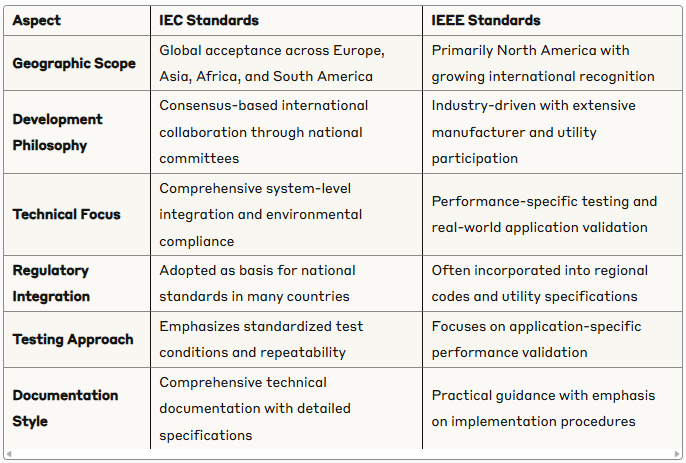
What Are the Key Differences Between IEC and IEEE Standards for Cables?
What are the key differences between IEC and IEEE standards for cables? Discover how global vs. regional compliance impacts cable safety, performance, and exportability.
hongjing.Wang@Feichun
7/17/20257 min read
Introduction
In the complex landscape of electrical engineering, standardization serves as the backbone of safety, quality, and interoperability. For cable engineers and manufacturers, understanding the nuances between different standardization bodies is not merely an academic exercise—it's a critical business imperative that directly impacts product development, market access, and regulatory compliance.
Two organizations stand at the forefront of electrical cable standardization: the International Electrotechnical Commission (IEC) and the Institute of Electrical and Electronics Engineers (IEEE). While both pursue the common goal of advancing electrical safety and performance, their approaches, geographic influences, and specific applications create a landscape where global cable standard compliance requires careful navigation between these two frameworks.
The electrical cable standard comparison between IEC and IEEE reveals fundamental differences in philosophy, scope, and implementation that every cable professional must understand. These differences extend far beyond mere technical specifications—they influence everything from manufacturing processes to international trade opportunities, making the mastery of both standards essential for success in today's interconnected global market.
What Are IEC Cable Standards?
The International Electrotechnical Commission, established in 1906 and headquartered in Geneva, Switzerland, represents the world's most comprehensive approach to electrical standardization. IEC cable standards form the foundation of electrical safety and performance requirements across Europe, Asia, Africa, and South America, making them truly global in scope and application.
Central to IEC electrical cable classification is the systematic approach to categorizing cables based on their construction, application, and performance characteristics. The IEC 60502-1 standard, which governs power cables with extruded insulation, exemplifies this comprehensive methodology. This standard defines everything from conductor materials and insulation requirements to testing procedures and marking systems, ensuring consistency across international markets.
IEC standards for power cables extend beyond basic construction requirements to encompass electromagnetic compatibility (EMC) through standards like IEC 61000, which addresses interference and compatibility issues that are increasingly important in our electronically dense world. The IEC 60204-1 standard focuses specifically on the safety of machinery's electrical equipment, establishing requirements that protect both equipment and personnel.
The emphasis on safety, environmental compliance, and performance consistency distinguishes IEC standards from their regional counterparts. These standards incorporate rigorous environmental testing requirements, considering factors such as temperature extremes, moisture exposure, and chemical resistance. This holistic approach ensures that cables meeting IEC standards can perform reliably across diverse global environments and applications.
IEC's consensus-based development process involves national committees from member countries, creating standards that reflect international best practices while accommodating regional variations. This collaborative approach results in standards that are both technically sound and practically implementable across different markets and regulatory environments.
What Are IEEE Cable Standards?
The Institute of Electrical and Electronics Engineers, formed in 1963 through the merger of the American Institute of Electrical Engineers and the Institute of Radio Engineers, brings an industry-driven perspective to standardization. IEEE cable testing standards reflect this practical approach, focusing on real-world performance requirements and industry-specific challenges.
American cable standards developed by IEEE are characterized by their emphasis on performance validation and industry collaboration. The IEEE 1202 standard for flame testing represents this philosophy, providing specific test methods for evaluating cable fire performance under conditions that reflect actual installation environments. This standard has become the benchmark for IEEE flame testing procedures worldwide.
The IEEE 802.3 Ethernet standard demonstrates how IEEE standards extend beyond traditional power cables to encompass data transmission systems. This standard defines the physical and data link layer specifications for Ethernet networks, including cable requirements that ensure reliable high-speed data transmission. The IEEE C37 series of protective relaying standards further illustrates the organization's focus on system-level performance and protection.
IEEE's industry-driven development process involves extensive participation from manufacturers, utilities, and end users, ensuring that standards address practical challenges faced in real-world applications. This approach results in standards that are often more prescriptive in their testing requirements and more specific in their performance criteria compared to their IEC counterparts.
The regional influence of IEEE standards, while primarily concentrated in North America, has expanded internationally as American companies have globalized their operations. This expansion has created a need for engineers worldwide to understand IEEE requirements, even when working in markets traditionally dominated by IEC standards.
IEC vs IEEE: What Are the Main Differences?
The differences between IEC and IEEE cable standards extend far beyond technical specifications to encompass fundamental philosophical approaches to standardization. Understanding these differences is crucial for cable engineers working on international projects and manufacturers seeking global market access.


The electrical standardization by region reveals how these differences manifest in practical applications. In Europe, IEC standards form the foundation of the Low Voltage Directive and other regulatory frameworks, making compliance mandatory for market access. In contrast, IEEE standards often serve as industry best practices in North America, with adoption driven by utility requirements and industry consensus rather than regulatory mandate.
These differences create challenges for engineers and manufacturers working on international projects. A cable designed to meet IEC 60502-1 requirements may not automatically satisfy IEEE 1202 flame testing requirements, even though both standards address similar safety concerns. This disparity necessitates careful analysis of project requirements and often leads to dual-standard compliance strategies.
The development timelines and revision cycles also differ between the two organizations. IEC standards typically undergo longer development and revision cycles, reflecting the complexity of achieving international consensus. IEEE standards may be updated more frequently to address rapidly evolving technology requirements, particularly in telecommunications and power system protection applications.


Why Cable Engineers Should Understand Both Standards
The importance of IEC and IEEE for international cable projects cannot be overstated in today's interconnected global economy. Cable engineers who understand both standardization frameworks possess a significant competitive advantage in designing systems that meet diverse market requirements while maintaining technical excellence and cost-effectiveness.
Global certification requirements increasingly demand compliance with multiple standards simultaneously. A power cable destined for an international infrastructure project may need to meet IEC 60502-1 requirements for basic performance while also satisfying IEEE 1202 flame testing criteria for specific installation environments. This dual-standard cable design approach requires deep understanding of both frameworks and their interrelationships.
The benefits of dual compliance extend beyond regulatory requirements to encompass market access and product reliability. Manufacturers who design cables to meet both IEC and IEEE standards can access broader markets without the need for extensive redesign or recertification. This approach reduces development costs while maximizing revenue potential across diverse geographic markets.
Professional development considerations also favor comprehensive understanding of both standards. Engineers with expertise in both IEC and IEEE frameworks are better positioned to lead international projects, consult on complex installations, and contribute to next-generation standard development. This expertise becomes increasingly valuable as the electrical industry continues to globalize and integrate across traditional regional boundaries.
The technical benefits of understanding both standards include improved problem-solving capabilities and enhanced design flexibility. Engineers familiar with both approaches can select the most appropriate testing methods, performance criteria, and safety requirements for specific applications, resulting in optimized solutions that meet all stakeholder requirements.
Case Study: Flame Retardant Requirements – IEC 60332 vs IEEE 1202
The comparison between IEC 60332 and IEEE 1202 flame testing standards provides a concrete example of how different approaches to standardization can impact cable design and selection. Both standards address the critical safety concern of fire performance, but their methodologies and acceptance criteria reflect the philosophical differences between their parent organizations.
IEC 60332 presents a comprehensive approach to cable safety standards for fire performance, with multiple parts addressing different aspects of flame propagation and smoke generation. The standard defines specific test conditions, including flame application methods, test duration, and damage assessment criteria. The emphasis is on creating standardized conditions that allow for reproducible results across different testing laboratories worldwide.
IEEE 1202, in contrast, focuses on specific performance validation under conditions that simulate actual installation environments. The standard's vertical flame test methodology provides a more application-specific assessment of cable performance, with acceptance criteria based on char length and flame propagation characteristics that reflect real-world fire scenarios.
The practical implications of these differences become apparent in international projects where cables must meet both standards. A cable that passes IEC 60332 requirements may not automatically satisfy IEEE 1202 criteria due to differences in test conditions, flame application methods, and acceptance thresholds. This necessitates careful material selection and potentially different formulations for insulation and jacket compounds.
Real-world case studies demonstrate how these standard differences impact project execution. In a recent multinational power plant project, cables meeting IEC 60332 requirements required additional testing to IEEE 1202 standards for installation in control rooms specified by American engineering firms. This dual testing requirement added both cost and schedule complexity to the project, highlighting the importance of early standard identification and compliance planning.
The evolution of both standards reflects ongoing collaboration between IEC and IEEE technical committees to harmonize testing methods while maintaining their distinct philosophical approaches. Recent revisions have introduced cross-references and correlation studies that help engineers understand the relationships between different test methods and their practical implications.
Conclusion
The landscape of cable standardization is fundamentally shaped by the complementary yet distinct approaches of IEC and IEEE. While IEC standards provide the global framework for electrical safety and performance, IEEE standards offer industry-specific guidance that addresses real-world application challenges. Understanding both frameworks is not merely beneficial—it's essential for cable engineers and manufacturers operating in today's international marketplace.
The technical excellence achieved through proper application of both standards creates a foundation for safer, more reliable electrical systems. Engineers who master both IEC and IEEE requirements can design cables that not only meet regulatory requirements but also exceed performance expectations across diverse applications and environments. This dual competency enables the development of innovative solutions that advance the state of the art while maintaining the highest safety standards.
The future of cable standardization will likely see continued convergence between IEC and IEEE approaches, driven by globalization and the need for international harmonization. However, the fundamental differences in philosophy and application will persist, making comprehensive understanding of both frameworks a permanent requirement for electrical professionals.
Standards serve as the bridge between technical innovation and practical implementation, ensuring that advances in cable technology translate into safer, more efficient electrical systems. By embracing both IEC and IEEE standards, the cable industry can continue to evolve while maintaining the safety and reliability that society depends upon. The investment in understanding both standardization frameworks pays dividends in improved product quality, expanded market access, and enhanced professional capabilities that benefit the entire electrical engineering community.
References
Primary Sources:
International Electrotechnical Commission (IEC). [Online]. Available: https://www.iec.ch/
Institute of Electrical and Electronics Engineers (IEEE). [Online]. Available: https://www.ieee.org/
Technical Literature:
Glover, J. Duncan, et al., "Power System Analysis and Design," Cengage Learning, latest edition.
Kuffel, Ron, "High Voltage Engineering: Fundamentals," Newnes, latest edition.
Standards References:
IEC 60502-1: Power cables with extruded insulation and their accessories for rated voltages from 1 kV (Um = 1,2 kV) up to 30 kV (Um = 36 kV)
IEC 60332: Tests on electric and optical fiber cables under fire conditions
IEEE 1202: Standard for Flame Testing of Cables for Use in Cable Trays in Industrial and Commercial Occupancies
IEEE 802.3: Standard for Ethernet
IEEE C37: Standard for Electrical Power System Device Function Numbers, Acronyms, and Contact Designations
To get a cable quote please fill out this form
How to Reach Us
Get in Touch
SiteMap
Product Catalogue
Reeling Cable
Festoon Cable
Shore Power Cable
Hybrid Cable


Copyright © 2025 Feichun Australia. All rights reserved.
